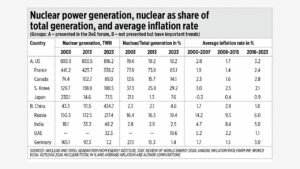Last week I attended the “Philippine International Nuclear Supply Chain Forum 2024” at Solaire Resort North in Quezon City. It was organized by the Department of Energy (DoE) and ran from Nov. 13-15, but I attended only the last two days.
Held on Nov. 13 was the Opening Ceremony with Keynote speeches from DoE Secretary Raphael P.M. Lotilla, US Ambassador to the Philippines MaryKay L. Carlson, and Special Assistant to the President on Investment and Economy Affairs Secretary Frederick D. Go (who was represented by his Assistant Secretary Marvin Jason Bayang). Then there were discussions on the US experience in nuclear energy development.
Nov. 14 focused on the nuclear energy experience of Canada in the morning, and that of France in the afternoon. The host in the morning session was Guy Boileau, Counselor and Senior Trade Commissioner of the Canadian embassy in the Philippines. A Welcome Message was given by the Ambassador of Canada, David Hartman. Among the speakers were Todd Smith, Vice-President of AtkinsRéalis’ Candu Energy, Inc., and Dr. Sara Supa-Amornkul also of AtkinsRéalis, a Thai-Canadian scientist who talked about CANDU (Canada Deuterium Uranium) technology as the only unenriched uranium technology in the world.
(I was one of several media participants who went along during the Philippines’ nuclear trade mission to Canada last March in Toronto, led by DoE Undersecretary Sharon Garin and other government officials. Mr. Boileau was with us and Todd Smith was the Energy Minster of Ontario at that time and we met him there. It was one of the most educational foreign trips I have ever attended.)
On the afternoon of Day 2, France’s Ambassador to the Philippines Marie Fontanel gave an overview of the two countries’ economic partnership and her country’s nuclear energy delegation. A talk on France’s extensive nuclear experience was delivered by Thomas Muisset, Nuclear Special Adviser of the French Government in Paris.
Nov. 15 focused on the nuclear energy experience of South Korea in the morning and of Japan in the afternoon. Opening remarks in the morning were given by Energy Regulatory Commission Monalisa Dimalanta. I like the discussion given by an official of Korea Hydro and Nuclear Power (KHNP) of KORI 2, a nuclear plant “twin” of our Philippine Nuclear Power Plant 1 (PNPP 1) in Bataan. Both were built by Westinghouse. Kori 2 produces 640 megawatts (MW) of power and was commissioned in 1983 while the PNPP 1 is capable of producing 620 MW and should have been commissioned in 1985 but was unlucky.
The afternoon of Day 3 had plenty of presentations from Japanese agencies, nuclear vendors, and energy companies — the Ministry of Economy, Trade and Industry (METI), Japan NUS Co. (JANUS) about their small modular reactors (SMR), from JGC, Hitachi-GE, and Japan Atomic Power Co. (JAPC).
When we were in Toronto last March, we saw the future site of Hitachi-GE’s SMR named BWRX 300 at the Ontario Power Generation (OPG) — it was small, about the size of one soccer field, and yet it can deliver 300 MW of 24/7 reliable and cheap electricity. That is beautiful.
Also that afternoon, Senator Sherwin Gatchalian came to the venue and I briefly chatted with him. I was happy when he told me that he regularly reads my column on energy, especially my discussion and critique of the LNG bill, but it has already been enacted into a law last week.
Congratulations to the DoE, especially Secretary Lotilla and Undersecretary Garin. Ms. Garin stayed all throughout the three-day event. I think it was very successful and gave the Philippine energy sector a wider perspective of these rich countries — the US, Canada, France, South Korea, and Japan — who have been industrialized for many decades now.
ON NUCLEAR ENERGY AND INFLATIONI checked again the nuclear power generation of these five countries, plus that of some other countries. I also compared their power generation with their consumer price stabilization. These are some interesting points I discovered:
1. Countries with rising nuclear power use experienced declining inflation rates — China, Russia, India, South Korea, and the United Arab Emirates (UAE).
2. Countries with declining nuclear power use experienced rising inflation rates — Germany, Japan, and France.
3. Countries with generally flat nuclear power use also experienced generally flat inflation rates — the US and Canada (see the table).
There are many factors why a country’s inflation rate rises, stays flat, or declines. But the cost of energy and electricity is one of the big contributors to inflation trends among countries. This should be one important incentive for the Philippines to go into nuclear power generation — to acquire many SMR units or quickly rehabilitate or refurbish BNPP 1 and proceed with BNPP 2 and other large nuclear plants.
I saw a press release from the Manila Electric Co. (Meralco) along with the Meralco Power Academy (MPA) about a recent visit to the Université Paris-Saclay (UPS) and top nuclear institutions in France. Meralco has a new initiative called nuclear energy strategic transition (NEST) and the visit to France was cool, exploring possible collaborations on capacity building and knowledge sharing.
Among the Meralco officials who went to France were Executive Vice-President and Chief Operating Officer Ronnie L. Aperocho, Senior Vice-President and Chief Human Resources Officer Edgardo V. Carasig, and First Vice-President and Head of Networks Froilan J. Savet.
UPS will be one of Meralco’s partner institutions for its Filipino Scholars and Interns on Nuclear Engineering (FISSION) program. The company sends young Filipinos abroad to cultivate the next generation of strong innovators and professionals in nuclear energy. Good move. Keep giving your consumers in the country stable, reliable, and competitively priced electricity.
Bienvenido S. Oplas, Jr. is the president of Bienvenido S. Oplas, Jr. Research Consultancy Services, and Minimal Government Thinkers. He is an international fellow of the Tholos Foundation.






